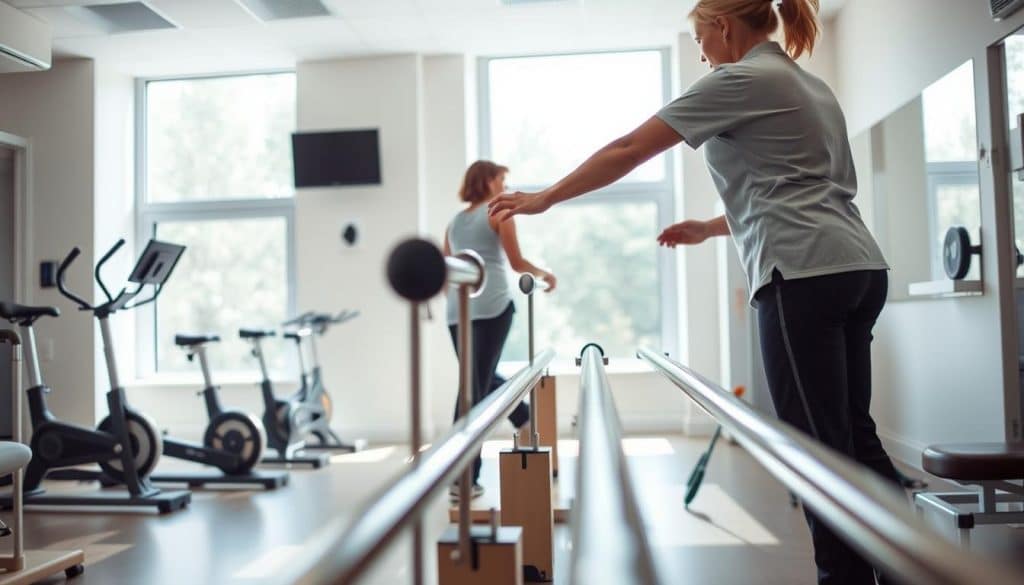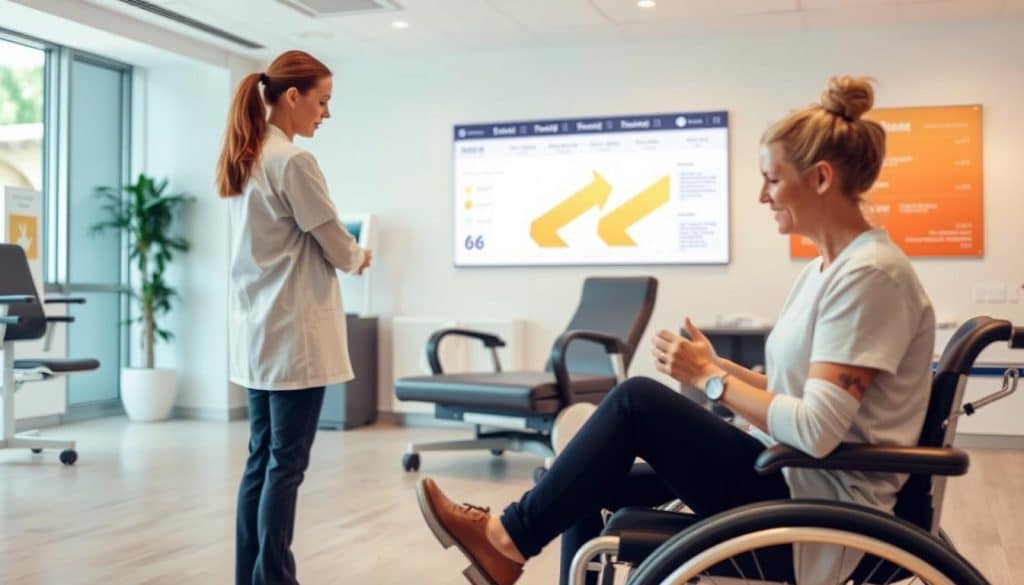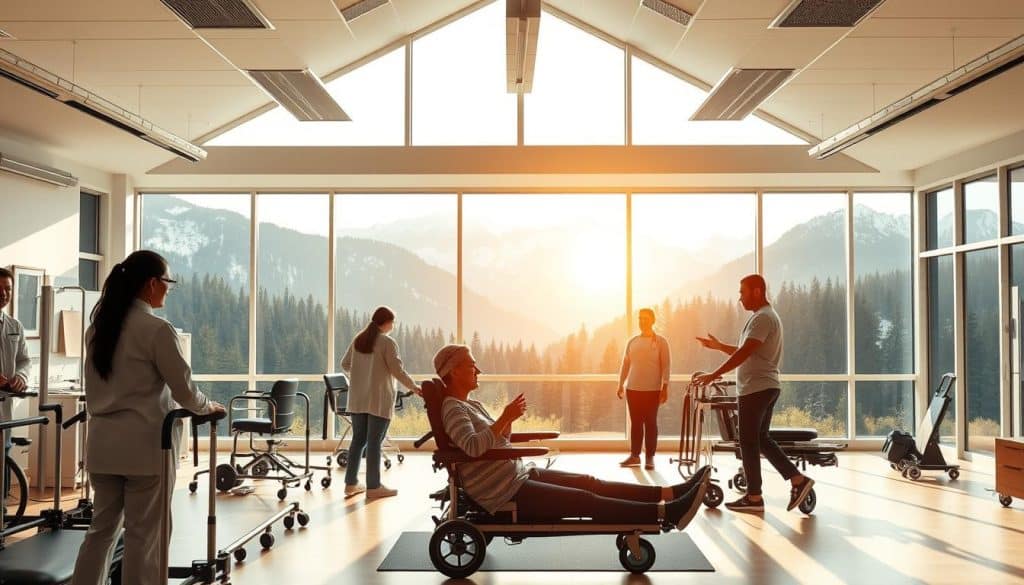Did you know that the human brain takes time to adjust to new physical demands after an injury or surgery? This adaptation process is crucial for optimal recovery. At Riverside Sports Therapy in Calgary, AB, Canada, experts understand the importance of adaptation in rehabilitation.
Research has shown that adaptation is a complex process involving the brain’s prediction of body movement and the costs associated with new task demands. Effective rehabilitation programs rely on a deep understanding of these principles to help patients achieve sustainable results.
For individuals seeking rehabilitation services in Calgary, understanding adaptation principles can make a significant difference in their recovery journey.
Key Takeaways
- Adaptation is a critical component of the rehabilitation process.
- Understanding adaptation principles is essential for effective rehabilitation programs.
- Riverside Sports Therapy provides expert guidance on adaptation principles in rehabilitation.
- Patients in Calgary can benefit from a comprehensive rehabilitation approach.
- Effective rehabilitation programs lead to optimal recovery outcomes.
Understanding Adaptation in Rehabilitation
Adaptation mechanisms are fundamental to the rehabilitation of patients with various health conditions. The term motor ‘adaptation’ has been used to describe distinct human motor behaviors, particularly the modification of movements based on error feedback. This process involves retaining the identity of a specific action while changing one or more parameters, occurring gradually over minutes to hours with repetition or practice.

Definition and Importance of Adaptation
Adaptation in rehabilitation refers to the body’s ability to adjust to new demands and limitations following injury, illness, or disability, involving both neurological and physical components. The importance of adaptation lies in its role as a fundamental mechanism that allows patients to regain function and independence despite altered physical capabilities.
- The brain’s neuroplasticity is the basis for adaptation principles in rehabilitation, enabling the reorganization of neural pathways in response to new experiences and challenges.
- Understanding adaptation as both a short-term adjustment process and a long-term learning mechanism helps rehabilitation professionals design more effective treatment protocols.
- Riverside Sports Therapy in Calgary emphasizes the importance of properly identifying and leveraging adaptation mechanisms to optimize rehabilitation outcomes for each individual patient.
| Key Aspects | Description |
|---|---|
| Neuroplasticity | The brain’s ability to reorganize neural pathways. |
| Short-term Adaptation | Immediate adjustments to new demands. |
| Long-term Learning | Gradual learning and improvement over time. |
The definition of adaptation encompasses both conscious compensatory strategies and unconscious neurological adjustments that occur during the rehabilitation process. By understanding these principles, healthcare professionals can better support patients throughout their recovery journey.
The Science Behind Adaptation Principles in Rehabilitation
The science behind adaptation principles in rehabilitation is rooted in complex neurological processes. Adaptation in rehabilitation refers to the brain’s ability to adjust to new demands or conditions, often as a result of injury or disease. This adaptability is crucial for patients to regain lost functions and improve their overall health.

Neurological Basis of Adaptation
The neurological basis of adaptation involves intricate interactions between various brain regions. The cerebellum plays a particularly crucial role in motor adaptation. Research has shown that damage to the cerebellum impairs the adaptation process, affecting trial-by-trial improvements during adaptation to new demands and diminishing the stored after-effect once the demand is removed.
Studies have demonstrated that sensory prediction errors drive the adaptation process in rehabilitation. These errors, which represent the difference between expected and actual movement outcomes, are sufficient to drive adaptation. Neuroimaging studies have revealed that successful adaptation activates neural networks involving the cerebellum, motor cortex, and basal ganglia, creating new pathways for movement control.
- The brain’s ability to form new neural connections, known as neuroplasticity, is the biological foundation that makes rehabilitation possible after injury or disease.
- Understanding the neurological mechanisms of adaptation allows rehabilitation professionals to design targeted interventions that enhance adaptive processes.
- Recent advances have shown that adaptation involves recalibrating the brain’s internal models of body movement and environmental interaction, rather than merely correcting errors.
By understanding these principles, rehabilitation professionals can develop training programs that are tailored to the specific needs of patients, thereby improving outcomes in rehabilitation.
Key Adaptation Principles in Rehabilitation
Adaptation principles play a vital role in the rehabilitation process, enabling patients to regain function and independence. Rehabilitation is a complex process that involves not only the recovery of physical abilities but also the adaptation to new limitations or challenges. Understanding the key principles that govern adaptation is essential for designing effective rehabilitation programs.
Error-Driven Motor Calibration
Error-driven motor calibration is a fundamental principle where the brain uses movement errors to adjust subsequent actions, gradually improving performance through trial and error. This process is critical in rehabilitation as it allows patients to learn new movement patterns and compensate for impairments. By iteratively refining their movements based on the errors experienced, patients can achieve more accurate and efficient motor control.
Sensory Prediction and Feedback
Sensory prediction and feedback mechanisms form a critical loop in rehabilitation. This loop allows patients to compare expected outcomes with actual results and make necessary adjustments. The integration of sensory feedback with motor output enables the nervous system to refine movement patterns, enhancing the adaptation process. Effective rehabilitation protocols often focus on enhancing sensory feedback to improve motor learning.
Cost Minimization in Movement
Cost minimization in movement is another key principle that explains how the body naturally seeks efficient movement patterns. These patterns reduce energy expenditure, pain, or instability during the rehabilitation process. The nervous system decides which ‘costs’ are most important to minimize to achieve the task’s goal. For instance, during walking or reaching adaptation, the body may alter movement patterns to minimize energy demands or forces that could cause fatigue or inaccuracy.
These adaptation principles work together to create a comprehensive framework for understanding how patients adapt to new physical limitations or challenges. Rehabilitation professionals apply these principles when designing progressive treatment protocols that challenge patients appropriately while facilitating optimal adaptation. By understanding these core principles, rehabilitation can be more targeted and effective, working with the body’s natural adaptation mechanisms.
Adaptation vs. Motor Learning in Rehabilitation
In the context of rehabilitation, understanding the distinction between adaptation and motor learning is crucial for effective treatment. Motor adaptation and learning are two processes fundamental to the flexibility of human motor control. Motor adaptation calibrates movement for novel demands, involving the recalibration of the brain’s prediction of how the body will move while considering the costs of new demands.
Repeated adaptation can lead to learning a new motor calibration, a process that is less understood but potentially critical for altering certain patients’ movement patterns on a more permanent basis.
Short-Term Adaptation Processes
Short-term adaptation processes involve immediate adjustments to movement patterns in response to new demands or limitations, typically occurring within a single rehabilitation session. These adaptations are essential for patients to cope with changing conditions or requirements during their rehabilitation training. For instance, a patient may adapt their gait to accommodate a new orthotic device.
Short-term adaptations serve as building blocks for long-term motor learning, allowing temporary adjustments to become permanent movement patterns with consistent practice.
Long-Term Motor Learning
Long-term motor learning represents the more permanent acquisition of new movement patterns through repeated practice and adaptation over multiple sessions or weeks. This process is vital for patients to regain functional abilities and achieve lasting improvements in their motor capabilities.
Research indicates that the transition from adaptation to learning requires specific practice conditions, including varied contexts, appropriate challenge levels, and sufficient repetition over time. Rehabilitation programs, such as those offered by Riverside Sports Therapy, are designed to facilitate both immediate adaptation and long-term motor learning through carefully structured progression of challenges.
| Characteristics | Short-Term Adaptation | Long-Term Motor Learning |
|---|---|---|
| Time Frame | Single rehabilitation session | Multiple sessions or weeks |
| Practice Conditions | Immediate adjustments | Repeated practice and adaptation |
| Outcome | Temporary adjustments | Permanent movement patterns |
The Rehabilitation Professional’s Role in Adaptation
Rehabilitation experts are essential in facilitating adaptation by undertaking thorough assessments and formulating personalized plans. Their role is multifaceted, involving the collection of relevant data to inform the rehabilitation process.
Assessment and Formulation
The assessment process is critical in identifying specific impairments, functional limitations, and the potential for adaptation in patients. Rehabilitation professionals must synthesize this data to create a clear understanding of the patient’s condition, developing a targeted intervention plan based on adaptation principles.
- Rehabilitation professionals conduct comprehensive assessments to identify patient needs and potential for adaptation.
- The formulation process involves creating a personalized plan tailored to the patient’s condition and needs.

Providing Expert Guidance
Providing expert guidance is a crucial aspect of the rehabilitation professional’s role. This involves educating patients about their condition, setting realistic expectations, and offering strategies to optimize the adaptation process. Effective rehabilitation professionals understand when to challenge patients and when to modify approaches based on individual responses and progress.
- Rehabilitation professionals educate patients and set realistic expectations to facilitate the adaptation process.
- Guidance is tailored to the individual, promoting optimal adaptation and learning.
Adaptation Strategies for Different Rehabilitation Contexts
The path to successful rehabilitation is paved with adaptation strategies suited to specific contexts. Rehabilitation centers have had to adapt their strategies, as seen during the COVID-19 pandemic when, according to the Latin American Medical Association of Rehabilitation (AMLAR), inpatient rehabilitation units were converted into dedicated COVID-19 recovery units. This drastic change highlighted the need for flexible and effective adaptation strategies in rehabilitation.
Inpatient Rehabilitation Settings
Inpatient rehabilitation settings provide a controlled environment where intensive daily therapy can significantly facilitate rapid adaptation for patients. The American Academy of Physical Medicine and Rehabilitation (AAPMR) recommended minimizing contact between patients without COVID-19 and other users in rehabilitation units, underscoring the importance of a controlled environment. Strategies in these settings focus on consistent, high-frequency interventions tailored to the specific needs of patients with severe impairments or complex conditions.
| Setting | Adaptation Strategies | Benefits |
|---|---|---|
| Inpatient | Intensive daily therapy, controlled environment | Rapid adaptation, tailored interventions |
| Outpatient | Self-directed practice, real-world application | Transferable skills, community integration |
Outpatient and Community-Based Rehabilitation
Outpatient and community-based rehabilitation contexts present unique challenges, requiring adaptation strategies that transfer to real-world environments and daily activities. 
Adaptation strategies must be tailored to the available resources, support systems, and physical environments in each rehabilitation context. For instance, outpatient settings require more self-directed practice, leveraging the patient’s environment to foster adaptation. By understanding these differences, healthcare providers can maximize the effectiveness of rehabilitation programs.
Adaptation Principles for Specific Conditions
In rehabilitation, the key to successful recovery lies in applying adaptation principles tailored to individual patient conditions. This personalized approach ensures that rehabilitation programs are effective in addressing the unique challenges presented by different health conditions.
Neurological Conditions
Neurological conditions such as stroke, traumatic brain injury, and Parkinson’s disease require specialized adaptation strategies. Research indicates that even with significant cerebral damage, patients can still adapt to new movement patterns. For instance, studies have shown that cerebral damage may slow the adaptation of reaching movements but does not eliminate this capability. Interestingly, adaptation of walking on a split-belt treadmill can remain intact and even improve the symmetry of stepping in some cases.
For neurological conditions, adaptation strategies focus on leveraging intact neural pathways, promoting neuroplasticity, and developing compensatory movement patterns when necessary. By understanding the pathophysiology of specific neurological conditions, rehabilitation professionals can target interventions that facilitate optimal adaptation and recovery.
Musculoskeletal Injuries
Musculoskeletal injuries present different adaptation challenges, often involving pain management, tissue healing considerations, and gradual loading progression to restore function. Effective rehabilitation for these injuries requires a tailored approach that addresses the specific needs of each patient. Riverside Sports Therapy specializes in condition-specific adaptation approaches that address the unique challenges and opportunities presented by different types of injuries.
By applying adaptation principles tailored to musculoskeletal injuries, rehabilitation professionals can help patients recover function and return to their normal activities. Understanding the specific adaptation challenges associated with different types of musculoskeletal injuries is crucial for developing effective rehabilitation programs.
Technology-Assisted Adaptation in Rehabilitation
Technology-assisted adaptation is becoming a crucial component of modern rehabilitation. The use of advanced technologies is revolutionizing the way patients adapt during the rehabilitation process.
Robotic Devices and Virtual Reality
Advanced technologies like robotic devices and virtual reality systems are providing precise, controlled environments that accelerate the adaptation process. Robotic devices deliver consistent, measurable perturbations that challenge patients’ movement patterns, driving adaptation in ways traditional therapy cannot. For instance, studies have shown that robotic arms can be used to perturb movement, helping patients adapt. However, research indicates that only 40% of adaptation driven by robots transfers to unconstrained movements.
| Technology | Benefits | Limitations |
|---|---|---|
| Robotic Devices | Consistent, measurable perturbations | Limited transfer to unconstrained movements |
| Virtual Reality | Immersive, engaging environments | Dependence on technology for adaptation |
Tele rehabilitation Approaches
Tele rehabilitation approaches have expanded access to adaptation-focused interventions, allowing patients to continue their rehabilitation process at home with remote guidance from professionals. This has been particularly beneficial for patients with mobility issues or those living in remote areas. Riverside Sports Therapy, for example, integrates cutting-edge technology with traditional hands-on approaches to optimize the adaptation process for patients with various conditions.
By leveraging technology, healthcare providers can offer personalized training programs that cater to the specific needs of patients, enhancing their overall health and rehabilitation outcomes.
Measuring Progress in Adaptation
Effective rehabilitation depends on the ability to measure and track adaptation progress accurately. Measuring progress in adaptation is crucial for understanding how patients are responding to rehabilitation interventions.
Assessment Tools and Methods
Measuring progress in adaptation requires specialized assessment tools and methods that can detect subtle changes in movement quality, efficiency, and functional performance. Riverside Sports Therapy in Calgary employs comprehensive assessment protocols that measure both the process of adaptation (how movements are performed) and the outcomes (what functions are restored). Standardized assessment tools provide objective measures of adaptation progress, allowing rehabilitation professionals to quantify improvements and adjust interventions accordingly.
Effective progress measurement considers both quantitative metrics (range of motion, strength, balance scores) and qualitative aspects (movement quality, confidence, self-efficacy). Regular reassessment throughout the rehabilitation process allows for timely adjustments to intervention strategies, ensuring optimal adaptation and preventing plateaus in recovery.

Tracking Functional Improvements
Tracking functional improvements involves measuring real-world performance in activities relevant to the patient’s goals, providing meaningful indicators of successful adaptation. Patients at Riverside Sports Therapy receive detailed progress reports that help them understand their adaptation journey and maintain motivation throughout the rehabilitation process.
By using a combination of assessment tools and methods, rehabilitation professionals can track progress and make data-driven decisions to optimize the rehabilitation process. As noted by experts, “Regular assessment and feedback are crucial for effective rehabilitation.”
“The key to successful rehabilitation is not just in the treatment itself, but in how well the treatment is tailored to the individual’s needs and progress.”
For more information on rehabilitation services or to schedule an appointment, please contact Riverside Sports Therapy at (403)283-7551, located in Calgary, AB, Canada.
Challenges in Adaptation During Rehabilitation
Adaptation during rehabilitation is fraught with challenges that can significantly impact patient outcomes. The process of rehabilitation is complex and multifaceted, involving various factors that can either facilitate or hinder a patient’s ability to adapt.
Patient-Related Barriers
Patient-related barriers play a significant role in hindering the adaptation process during rehabilitation. Psychological factors such as fear of movement, depression, or anxiety can inhibit a patient’s willingness to engage in challenging rehabilitation activities.
- Physiological barriers, including pain, fatigue, and comorbid conditions, can significantly impact a patient’s capacity for adaptation.
- Understanding these barriers is crucial for rehabilitation professionals to develop proactive strategies that minimize their impact on the adaptation process.
Environmental and Systemic Challenges
Environmental and systemic challenges also pose significant obstacles to effective adaptation during rehabilitation. Limited access to appropriate rehabilitation facilities, equipment, or supportive home environments can hinder the practice of newly adapted skills.
- Systemic challenges within the healthcare system, such as insurance limitations, fragmented care, and insufficient rehabilitation duration, can interrupt the adaptation process prematurely.
- Riverside Sports Therapy in Calgary addresses these challenges through comprehensive assessment, individualized approaches, and advocacy for appropriate rehabilitation resources.
Successful rehabilitation programs anticipate common challenges and incorporate strategies to overcome them, ensuring continuous progress despite obstacles.
The Role of Patient Education in Adaptation
In rehabilitation, patient education is fundamental to facilitating a successful adaptation process. Patient education not only empowers individuals with the knowledge they need to navigate their recovery but also sets the stage for a more effective rehabilitation process.
Educational Foundations for Adaptation
Providing accurate and comprehensive information is crucial in the adaptation process. This includes educating patients about their condition, the recovery process, and the principles behind adaptation. By understanding what to expect, patients can better cope with the challenges of rehabilitation.
- Understanding the condition and its implications
- Knowledge of the recovery timeline and milestones
- Awareness of the neurological basis of adaptation
Setting realistic expectations is also vital. Education helps in managing patient expectations, thereby reducing frustration and enhancing engagement in the rehabilitation process.
| Education Component | Description | Benefits |
|---|---|---|
| Condition Understanding | Information about the patient’s condition | Better coping mechanisms |
| Recovery Expectations | Timeline and milestones of recovery | Reduced frustration |
| Adaptation Principles | Neurological basis of adaptation | Enhanced patient engagement |
Empowering Patients Through Education
Empowering patients involves more than just providing information; it includes teaching them to recognize signs of successful adaptation and how to problem-solve when challenges arise. Riverside Sports Therapy emphasizes a comprehensive approach to patient education, going beyond basic information to include the rationale behind rehabilitation strategies.
By understanding the principles of adaptation, patients are more likely to adhere to their rehabilitation programs and practice independently, thereby accelerating their recovery. Effective patient education is ongoing and tailored to each stage of recovery and adaptation.
Family and Caregiver Involvement in Adaptation
Family and caregiver involvement is a cornerstone of effective rehabilitation, significantly influencing adaptation outcomes. The support provided by family members and caregivers extends beyond the formal rehabilitation sessions, playing a critical role in a patient’s daily life and overall recovery process.
Supporting the Adaptation Process
To effectively support the adaptation process, families need to understand the principles of adaptation and how to create an environment that fosters progress. This involves being aware of the patient’s needs, providing encouragement, and assisting with practice outside formal rehabilitation sessions. Research has shown that patients with involved, well-informed families typically exhibit faster adaptation and better long-term outcomes. “The involvement of family members in the rehabilitation process can significantly enhance a patient’s ability to adapt,” highlighting the importance of a collaborative approach to rehabilitation.
Training Caregivers in Adaptation Principles
Training caregivers in adaptation principles is essential for promoting independence rather than dependence during daily activities. Effective caregiver training includes hands-on practice with supervision, education on when to assist versus when to allow productive struggle, and strategies for managing caregiver stress. By empowering caregivers with the necessary knowledge and skills, rehabilitation programs can ensure continuity between formal sessions and daily life, allowing for more consistent practice and reinforcement of adaptive strategies. Riverside Sports Therapy in Calgary incorporates family education and training as a standard component of their rehabilitation programs, recognizing the crucial role that family and caregivers play in successful adaptation.
Riverside Sports Therapy’s Approach to Adaptation in Rehabilitation
At Riverside Sports Therapy, a leading rehabilitation center in Calgary, adaptation is at the forefront of their treatment strategies. Their approach to rehabilitation emphasizes the importance of adaptation in the recovery process, ensuring that patients receive the most effective care.
Specialized Programs and Services
Riverside Sports Therapy offers specialized rehabilitation programs that apply adaptation principles to optimize recovery for patients with various conditions and injuries. Their rehabilitation services include sport-specific programs designed for athletes returning to high-level performance after injury.
These programs are tailored to individual needs, integrating evidence-based adaptation strategies with personalized assessment and treatment planning.
Expert Team and Facilities
The clinic is staffed by professionals with advanced training in neurological rehabilitation, orthopedic rehabilitation, and sports medicine, providing comprehensive expertise in adaptation principles. State-of-the-art facilities equipped with specialized technology and equipment create optimal environments for facilitating adaptation across different movement patterns and functional activities.
Patients can access these specialized services by calling (403)283-7551 to schedule an assessment with one of Riverside’s adaptation experts in Calgary.
Case Studies: Successful Adaptation in Rehabilitation
The effectiveness of adaptation principles in rehabilitation is best illustrated through real-life case studies. These studies demonstrate how individuals with various conditions, from stroke survivors to athletes with sports injuries, have benefited from tailored rehabilitation programs.
Neurological Rehabilitation Success Stories
Case studies of successful neurological rehabilitation show how adaptation principles applied consistently over time can lead to remarkable recovery even in complex conditions like stroke or traumatic brain injury. For instance, a stroke survivor regained walking ability through targeted adaptation interventions that gradually challenged balance and coordination systems, resulting in new movement patterns.
These success stories highlight the importance of consistent practice, appropriate progression of challenges, and comprehensive education in the rehabilitation process.
Sports Injury Rehabilitation Outcomes
Sports injury rehabilitation outcomes also demonstrate the effectiveness of adaptation-focused approaches. Elite and recreational athletes alike benefit from programs that restore not just basic function but performance-level movement quality. A notable example is a professional soccer player’s successful return to competition following ACL reconstruction, illustrating how progressive adaptation challenges can rebuild both physical capacity and movement confidence.
Common elements in these successful cases include strong support systems that reinforce adaptation, underscoring the potential for recovery when adaptation principles are optimally applied in rehabilitation settings.
Conclusion: The Future of Adaptation Principles in Rehabilitation
As research continues to advance our understanding of neuroplasticity and motor learning, the future of adaptation principles in rehabilitation appears increasingly promising. Emerging technologies like artificial intelligence, advanced biofeedback systems, and wearable sensors are likely to enhance our ability to measure and facilitate adaptation with unprecedented precision. This technological integration, combined with a deeper understanding of individual patient characteristics, may lead to more personalized and effective rehabilitation strategies.
Riverside Sports Therapy remains at the forefront of implementing evidence-based adaptation principles in rehabilitation, continually integrating new research findings into clinical practice. The growing emphasis on preventive rehabilitation may also shift focus toward optimizing adaptation before significant problems develop, particularly in aging populations and athletic performance. Interdisciplinary collaboration between rehabilitation sciences, neuroscience, psychology, and technology will continue to advance our understanding and application of adaptation principles.
For patients in Calgary seeking expert guidance on adaptation principles in rehabilitation, Riverside Sports Therapy can be contacted at (403)283-7551 to begin their journey toward optimal recovery and function. As our understanding of adaptation continues to evolve, the fundamental principle remains constant: the human body and brain possess a remarkable capacity for change when provided with appropriate challenges and support, ultimately enhancing patients’ overall health and rehabilitation outcomes.
